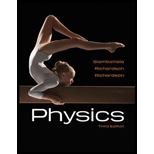
Concept explainers
(a)
The potential energy, and kinetic energy of particle at time
(a)
Answer to Problem 100P
The potential energy of particle at time
Explanation of Solution
Consider the graph of potential energy plotted against distance.
It is given that at
The total energy of the system is the sum of potential and kinetic energy. Hence, the expression for kinetic energy is given below
Here,
The total energy of the system is
Conclusion:
Substitute
Therefore, the potential energy of particle at time
(b)
The total, potential, and kinetic energy of particle at
(b)
Answer to Problem 100P
The total energy is
Explanation of Solution
The total energy of the system is already fixed, and it is
From graph potential energy at
Same as part (a) use the expression for kinetic energy.
Conclusion:
Substitute
Therefore, the total energy is
(c)
The kinetic energy of particle at
(c)
Answer to Problem 100P
The kinetic energy of particle at
Explanation of Solution
From graph the potential energy at
Similar to the above cases find kinetic energy by using equation (I) in part (a)
Conclusion:
Substitute
Therefore, the kinetic energy of particle at
(d)
To describe the motion of particle starting at
(d)
Answer to Problem 100P
The particle starting from
Explanation of Solution
At
The particle moves to right with increasing kinetic energy till it reaches
Want to see more full solutions like this?
Chapter 6 Solutions
Physics - With Connect Access
 College PhysicsPhysicsISBN:9781305952300Author:Raymond A. Serway, Chris VuillePublisher:Cengage Learning
College PhysicsPhysicsISBN:9781305952300Author:Raymond A. Serway, Chris VuillePublisher:Cengage Learning University Physics (14th Edition)PhysicsISBN:9780133969290Author:Hugh D. Young, Roger A. FreedmanPublisher:PEARSON
University Physics (14th Edition)PhysicsISBN:9780133969290Author:Hugh D. Young, Roger A. FreedmanPublisher:PEARSON Introduction To Quantum MechanicsPhysicsISBN:9781107189638Author:Griffiths, David J., Schroeter, Darrell F.Publisher:Cambridge University Press
Introduction To Quantum MechanicsPhysicsISBN:9781107189638Author:Griffiths, David J., Schroeter, Darrell F.Publisher:Cambridge University Press Physics for Scientists and EngineersPhysicsISBN:9781337553278Author:Raymond A. Serway, John W. JewettPublisher:Cengage Learning
Physics for Scientists and EngineersPhysicsISBN:9781337553278Author:Raymond A. Serway, John W. JewettPublisher:Cengage Learning Lecture- Tutorials for Introductory AstronomyPhysicsISBN:9780321820464Author:Edward E. Prather, Tim P. Slater, Jeff P. Adams, Gina BrissendenPublisher:Addison-Wesley
Lecture- Tutorials for Introductory AstronomyPhysicsISBN:9780321820464Author:Edward E. Prather, Tim P. Slater, Jeff P. Adams, Gina BrissendenPublisher:Addison-Wesley College Physics: A Strategic Approach (4th Editio...PhysicsISBN:9780134609034Author:Randall D. Knight (Professor Emeritus), Brian Jones, Stuart FieldPublisher:PEARSON
College Physics: A Strategic Approach (4th Editio...PhysicsISBN:9780134609034Author:Randall D. Knight (Professor Emeritus), Brian Jones, Stuart FieldPublisher:PEARSON





